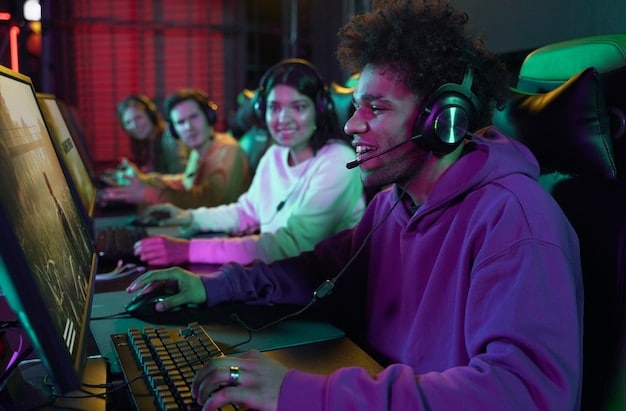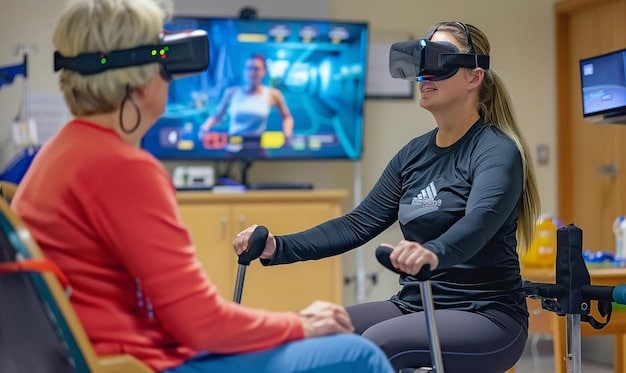PC Gaming Accessibility: New Tools & Technologies for US Gamers

PC gaming accessibility in the US is rapidly evolving, integrating new tools and technologies to empower gamers with disabilities through innovative hardware, software, and community-driven initiatives that enhance inclusivity and redefine the gaming experience for all.
The landscape of PC Gaming Accessibility: New Tools and Technologies for Gamers with Disabilities in the US is undergoing a transformative period. For years, the gaming community has championed inclusivity, but recent advancements are truly democratizing play. This commitment ensures that the thrill and engagement of PC gaming are accessible to everyone, regardless of their physical or cognitive abilities.
The evolving landscape of PC gaming accessibility
The pursuit of accessibility in PC gaming is not merely a trend; it represents a fundamental shift in how developers, manufacturers, and the gaming community perceive and engage with players. Historically, gaming has presented barriers for individuals with disabilities, primarily due to control schemes, visual interfaces, and auditory cues designed for typical physical and sensory capabilities. However, a growing awareness, coupled with technological innovation and advocacy from disabled gamers themselves, has spurred significant progress. This evolution is driven by the understanding that gaming is a powerful medium for connection, storytelling, and challenge, and its benefits should be universally available.
Understanding the core challenges
For many years, the primary hurdles for gamers with disabilities included a lack of customizable input options, inaccessible user interfaces (UI), and insufficient visual or auditory aids. Traditional keyboard and mouse setups, while versatile for many, present significant challenges for those with limited dexterity, muscle control issues, or limb differences. Similarly, games relying heavily on quick reflexes, intricate button combinations, or precise aiming can exclude a substantial segment of the gaming population.
* Limited input methods beyond standard peripherals.
* User interfaces not adaptable for various sensory or cognitive needs.
* Lack of in-game options for visual, auditory, or cognitive adjustments.
The paradigm shift in developer mindset
A crucial turning point has been the increasing willingness of game developers and publishers to integrate accessibility features from the ground up, rather than as an afterthought. This proactive approach ensures that accessibility is woven into the design fabric of a game, resulting in more natural and effective solutions. Major players in the industry, including Microsoft, Sony, and independent studios, are dedicating resources to hire accessibility consultants, conduct user testing with disabled gamers, and implement comprehensive accessibility guidelines. This fundamental shift acknowledges that accessibility is not a niche consideration but a core component of good game design. This has led to the development of dedicated accessibility teams within studios and a greater focus on inclusive design principles. The emphasis is now on creating experiences that are inherently flexible and adaptable, catering to a wider array of needs without compromising the gameplay experience. This new methodology aims to reduce the need for external assistive technologies, though they remain vital, by embedding solutions directly into the games themselves.
Groundbreaking adaptive hardware innovations
The advancement of specialized hardware is one of the most exciting frontiers in PC gaming accessibility. These innovations directly address physical barriers, allowing gamers to interact with games in ways previously unimaginable. These devices range from highly modular controllers to eye-tracking systems, each designed with specific forms of disability in mind. The goal is to provide intuitive and responsive input methods that transcend the limitations of conventional keyboards and mice, empowering players to engage with their favorite titles on their own terms.
Modular and customizable controllers
The Microsoft Xbox Adaptive Controller (XAC) stands as a beacon of innovation in this space. While primarily designed for Xbox, its USB connectivity and compatibility with Windows PCs make it a powerful tool for PC gamers. The XAC allows users to plug in a wide array of external assistive devices, such as joysticks, buttons, and switches, creating a highly personalized control setup. Its modular nature means it can be configured to suit various disabilities, from those with limited hand function to individuals who game using their feet or other body parts. This device has sparked a wave of similar design philosophies, encouraging the development of more adaptable peripherals. Other examples include specialist joysticks with customized grips or larger buttons, and systems that allow for single-hand operation. These controllers often feature remappable buttons and adjustable sensitivity, offering unparalleled flexibility.
* Microsoft Xbox Adaptive Controller (XAC): A hub for external assistive devices.
* Customizable button layouts and remapping capabilities.
* Compatibility with a wide range of switches, joysticks, and other inputs.
Specialized input devices
Beyond modular controllers, other specialized input devices are transforming how disabled gamers play. Eye-tracking technology, for example, allows users to control game elements or navigate menus simply by looking at the screen. This is particularly beneficial for individuals with severe motor impairments. Companies like Tobii Dynavox are at the forefront of this technology, developing advanced eye-tracking systems that integrate seamlessly with PC games. Similarly, mouth-controlled joysticks and sip-and-puff devices provide hands-free control for those who can only use their breath. These devices often require a learning curve but offer incredible liberation and independence for gamers. Voice control software has also matured, allowing players to issue commands and navigate interfaces with spoken words. Brain-computer interfaces (BCIs), while still nascent, represent the cutting edge, offering the potential for direct neural control of gaming experiences. As these technologies become more refined and affordable, they hold immense promise for expanding gaming to an even broader audience.

Sophisticated software solutions for accessibility
While innovative hardware opens up new avenues for physical interaction, powerful software tools provide equally critical support by addressing cognitive, visual, and auditory barriers within games. These solutions range from operating system-level features to in-game options specifically designed to enhance accessibility, ensuring that the gaming experience is not just playable, but truly enjoyable and immersive for everyone. The beauty of software solutions lies in their flexibility and the ease with which updates and improvements can be rolled out, constantly refining the accessibility landscape.
Operating system level features
Both Windows and macOS offer a suite of built-in accessibility features that directly benefit PC gamers. These include robust screen readers like Narrator (Windows) and VoiceOver (macOS), which convert text and interface elements into spoken words, empowering visually impaired gamers to navigate menus and understand on-screen information. Magnifier tools allow users to zoom in on specific parts of the screen, enhancing visibility for those with low vision. Furthermore, features like Sticky Keys, Filter Keys, and Toggle Keys modify keyboard behavior to assist users with motor impairments by simplifying complex key combinations or ignoring accidental presses. Color filters and high-contrast modes transform visual displays to aid gamers with color blindness or light sensitivity. These operating system-level provisions form a foundational layer of accessibility, providing essential tools before a game even launches.
* Screen readers (Narrator, VoiceOver) for auditory feedback.
* Magnifier tools for visual assistance.
* Keyboard modifications (Sticky Keys, Filter Keys, Toggle Keys) for motor control.
* Color filters and high-contrast modes for visual impairments.
In-game accessibility options
Modern game developers are increasingly integrating a wide array of accessibility options directly into their games. This approach ensures that features are optimized for the specific game experience and are readily available to players without the need for external software or complex configurations. Examples include fully remappable controls, allowing players to assign any action to any input. Subtitle customization, including adjustable size, color, background, and speaker identification, is crucial for deaf or hard-of-hearing gamers. Colorblind modes provide visual filters to distinguish colors that might otherwise appear similar. Difficulty scaling options allow players to adjust game speed, enemy health, or puzzle complexity. Options for reducing screen shake, motion blur, or flashing lights cater to players with motion sickness or photosensitive epilepsy. Beyond these, some games offer text-to-speech chat, audio cues for visual events, or even advanced AI assistance to help with aiming or navigation. The comprehensive nature of these in-game solutions represents a significant leap forward in making games truly inclusive.
Community advocacy and resources
Beyond technological advancements, the driving force behind PC gaming accessibility is often the passionate and unwavering advocacy of disabled gamers and their allies. These communities play a crucial role in raising awareness, conducting research, developing resources, and directly influencing developers to prioritize inclusivity. Their collective voice ensures that the needs and preferences of disabled players are heard and addressed, pushing the industry towards a more accessible future. This grassroots movement is fundamental in shaping the direction of accessibility efforts.
Grassroots initiatives and organizations
Numerous non-profit organizations and grassroots initiatives are dedicated to promoting accessibility in gaming. Groups like AbleGamers Charity, DBLTAP, and SpecialEffect (though based in the UK, they influence US efforts) work tirelessly to provide adaptive equipment, conduct research, and educate developers. These organizations often run fundraising campaigns, host accessible gaming events, and offer one-on-one assistance to gamers seeking custom solutions. Their work extends beyond providing equipment, fostering a supportive community where disabled gamers can connect, share experiences, and find solidarity. Such organizations are vital conduits between the disabled gaming community and game developers, translating real-world needs into actionable design principles. They frequently publish detailed guides and frameworks that help developers understand and implement accessibility features effectively.
* AbleGamers Charity: Provides resources and advocates for accessibility.
* SpecialEffect: Develops custom control setups and advises developers.
* The work of these groups often includes user testing, research, and direct support.
User generated accessibility content
The gaming community itself is a rich source of accessibility solutions. Many disabled gamers share their experiences, recommendations, and custom configurations online, creating a valuable knowledge base for others. This includes tutorials for setting up specific assistive technologies, reviews of games from an accessibility perspective, and discussions on forums about workarounds for inaccessible features. Modding communities also contribute significantly, developing patches or custom settings that improve the accessibility of older or less inclusive games. This collaborative spirit, often seen on platforms like Reddit, Discord, and YouTube, ensures that even when official support is lacking, creative solutions emerge from the players themselves. Websites like “Can I Play That?” offer comprehensive accessibility reviews written by disabled gamers, providing invaluable insights for prospective players. This ecosystem of shared knowledge and collective problem-solving exemplifies the power of community in driving accessibility forward.
The role of streamers and content creators
Accessible gaming content creators and streamers amplify the message of inclusivity. By showcasing their gaming experiences, often using adaptive equipment, they not only entertain but also educate broader audiences about the realities and joys of accessible gaming. Their platforms become powerful tools for advocacy, demonstrating what’s possible and inspiring both disabled and non-disabled individuals. These creators also provide direct feedback to developers, highlighting accessibility triumphs and areas for improvement in real-time. Their visibility helps to normalize and celebrate disability in gaming, breaking down stereotypes and fostering a more welcoming environment for everyone.
Case studies: games leading the way
Examining specific games that have made substantial strides in accessibility offers concrete examples of how theory translates into practice. These titles demonstrate a commitment to inclusive design, serving as benchmarks for the industry and proving that accessible game design can coexist with critical acclaim and commercial success. Their foresight in including a broad range of options underscores a positive trend for the future of PC gaming.
“The Last of Us Part II” and its comprehensive suite
Naughty Dog’s “The Last of Us Part II” is widely regarded as a gold standard for accessibility in modern gaming. The game features over 60 accessibility options, encompassing motor, visual, and auditory needs. This includes fully customizable controls, text-to-speech for all on-screen text, visual aids for audio cues, and even options that simplify navigation and combat. Blind gamers, for example, can leverage an intricate set of descriptive audio cues and traversal assistance features that guide them through environments. Deaf players benefit from highly customizable subtitles and visual indicators for sounds. The sheer breadth and depth of these options ensure that a wide range of disabled gamers can experience the title from start to finish, a testament to Naughty Dog’s dedication. This game proved that high-fidelity, narrative-driven experiences can be made massively accessible without compromising original artistic vision. The settings menu itself is a masterclass in organization and clarity, making it easy for players to find and adjust what they need.
“Forza Motorsport” and racing accessibility
The “Forza Motorsport” series, particularly its recent iterations, has consistently led the charge in racing game accessibility. Turn 10 Studios has implemented numerous features that allow players with various physical limitations to enjoy high-speed racing. This includes options for one-button steering, adjustable braking assist, and full throttle assistance. Visual aids such as clearer racing lines and configurable heads-up displays reduce cognitive load. The “Auto Steer” and “Auto Brake” features allow players to focus on strategic decisions rather than precise manual control, making the intensity of racing accessible to new audiences. These tools not only make the game playable but also competitive for a broader range of players, fostering a more inclusive racing community. Beyond the driving mechanics, menu navigation and UI elements are also designed with accessibility in mind, often offering scalable text and high-contrast options. The focus is on allowing players to engage with the core thrill of racing, regardless of their control method limitations.
Independent games and innovative approaches
Beyond AAA titles, many independent game developers are pushing the boundaries of accessibility with innovative and often unconventional solutions. Due to their smaller scale, indie studios can sometimes experiment more freely with design. “Celeste,” a challenging platformer, includes an “Assist Mode” that allows players to modify game speed, invincibility, or infinite stamina, providing a vital pathway for gamers who might otherwise be unable to progress. “Tunic,” an action-adventure game, incorporates a “No Fail Mode” and options to remove stamina limits, ensuring the engaging world and puzzles are accessible even if combat is a barrier. These examples highlight a growing trend where accessibility features are seen not as compromises, but as essential design choices that broaden a game’s appeal and ensure everyone can engage with its core experience. Indie developers often have a more direct relationship with their player base, allowing them to iterate and respond to accessibility needs more rapidly.
Challenges and the path forward
Despite significant progress in PC gaming accessibility, the journey towards true inclusivity is ongoing, fraught with persistent challenges and demanding continuous innovation. These obstacles range from technical hurdles to broader industry adoption and the education of developers. Addressing these issues cohesively will be critical to ensuring that the advancements made are not just isolated successes but become standard practice across the gaming landscape.
Addressing the “accessibility tax”
One of the persistent challenges is the “accessibility tax,” where specialized adaptive equipment often comes with a prohibitive price tag. While the Xbox Adaptive Controller is relatively affordable, many high-end eye-tracking systems, custom switches, or sophisticated assistive joysticks cost hundreds or even thousands of dollars. This financial barrier prevents many disabled gamers from accessing the very tools designed to help them. Addressing this requires greater investment from manufacturers, potentially government subsidies, and the development of more affordable open-source solutions. Making these essential technologies more accessible will be crucial for broader adoption. The cost of maintaining and upgrading these devices also adds to the burden, requiring a more sustainable economic model for accessibility hardware.
Standardization and awareness
Currently, accessibility implementation varies widely from game to game. A lack of universal standards or consistent guidelines means that developers often reinvent the wheel, or worse, overlook crucial accessibility features. While organizations like the IGDA Accessibility Special Interest Group are working on guidelines, their adoption is not yet mandatory. Increased awareness among developers, producers, and educators about accessible design principles is vital. Integrating accessibility into game design curricula and professional development programs can ensure future generations of developers build inclusively from day one. Consistent labeling and clear communication about accessibility features on game store pages would also empower consumers to make informed choices. The industry needs to coalesce around a common set of best practices, ensuring a baseline level of accessibility across all titles.
The ongoing dialogue and future innovations
The future of PC gaming accessibility hinges on continuous dialogue between disabled gamers, developers, and hardware manufacturers. This back-and-forth ensures that innovations are truly responsive to real-world needs. Emerging technologies like enhanced haptic feedback, more sophisticated AI-driven assistance, and further integration of thought-controlled interfaces hold immense promise. Virtual reality (VR) and augmented reality (AR) also present new frontiers for accessibility, though they come with their own unique set of challenges. As technology progresses, the opportunities to break down barriers will only grow, but it requires sustained commitment and an unwavering focus on inclusivity. The journey is far from over, but the momentum is undeniable and the collective effort to ensure everyone can play is stronger than ever.
The impact of accessibility on the gaming community
The drive for greater accessibility in PC gaming is not merely about enabling individuals with disabilities to play; it profoundly enriches the entire gaming community and elevates the art form itself. When games are designed with inclusivity in mind, they become more robust, more innovative, and ultimately, more appealing to a broader audience. This shift fosters a more vibrant and diverse community that benefits everyone involved, transcending the traditional scope of game design.
Expanding the player base and market
First and foremost, making games accessible directly expands the potential player base. There are an estimated 61 million adults with a disability in the US, many of whom are interested in gaming. By removing barriers, developers tap into a significant and underserved market segment. This isn’t just about social responsibility; it makes sound business sense. Games that are accessible from the outset often garner positive press, build brand loyalty, and attract a wider demographic of players, leading to increased sales and revenue. Furthermore, features designed for disabled gamers often benefit non-disabled players too, improving the overall user experience for everyone. For instance, customizable controls and clear subtitles are universally appreciated.
Fostering innovation and creativity
The challenge of designing for accessibility often sparks incredible innovation. When developers are forced to think outside the box to accommodate diverse needs, fresh ideas and creative solutions often emerge. This can lead to new control schemes, innovative UI designs, and novel gameplay mechanics that might not have been conceived without the focus on inclusivity. Necessity, in this case, truly becomes the mother of invention. For example, the detailed audio design required for visually impaired players can enhance the atmospheric experience for all players. The constraints imposed by accessibility challenges often lead to more elegant and universally applicable designs.
Promoting empathy and diversity
A more accessible gaming landscape naturally promotes greater empathy and diversity within the community. When disabled gamers can fully participate, it normalizes disability and breaks down stereotypes. It allows individuals from varied backgrounds to connect, share experiences, and compete on an equal footing, fostering a more understanding and inclusive environment. This cultural shift is perhaps the most profound impact of accessibility efforts, creating a gaming world where everyone feels welcome and valued. As more diverse voices enter the community, discussions around game design and the future of gaming become richer and more representative of the global player base. This builds a society that values differences and creates a gaming culture that reflects the richness of human experience.

| Key Point | Brief Description |
|---|---|
| 🎮 Adaptive Hardware | New modular controllers and specialized input devices are breaking down physical barriers for gamers. |
| 🖥️ Software Solutions | OS-level features and extensive in-game options enhance visual, auditory, and cognitive accessibility. |
| 🤝 Community Advocacy | Grassroots movements and content creators drive awareness and influence inclusive game design. |
| 🚀 Future Outlook | Ongoing innovation and collaboration are vital to overcome challenges and ensure universal gaming access. |
Frequently asked questions about PC gaming accessibility
▼
The Xbox Adaptive Controller (XAC) is a hub designed to work with various external assistive devices like switches, buttons, and joysticks. It connects to Windows PCs via USB, allowing gamers with diverse physical disabilities to create a custom input setup tailored to their needs, overcoming traditional keyboard and mouse limitations.
▼
Yes, eye-tracking technologies are incredibly beneficial, especially for gamers with severe motor impairments. They allow players to control game cursors, navigate menus, or even perform in-game actions simply by gazing at different parts of the screen, providing a hands-free gaming experience.
▼
Look for features like fully remappable controls, customizable subtitles (size, color, background), colorblind modes, difficulty scaling, options to reduce screen shake or flashing lights, and text-to-speech for UI. Comprehensive options indicate a developer’s commitment to inclusivity.
▼
Organizations like AbleGamers Charity and SpecialEffect provide adaptive equipment, conduct research, and educate developers on best practices. They also foster supportive communities for disabled gamers, ensuring their voices are heard and their needs are met, driving systematic change within the industry.
▼
No, PC gaming accessibility addresses a wide range of needs beyond physical disabilities. It includes features for cognitive impairments (e.g., adjustable game speed), visual impairments (e.g., screen readers, high contrast modes), and auditory impairments (e.g., detailed subtitles, visual sound cues), aiming for comprehensive inclusivity.
Conclusion
The journey of PC gaming accessibility in the US represents a compelling narrative of technological innovation meeting human empathy. From the foundational support of operating system features to the groundbreaking adaptive hardware and the meticulous in-game options, the barriers to entry for gamers with disabilities are continuously being dismantled. This progress is not merely a testament to the capabilities of technology but also to the unwavering advocacy of disabled gamers and their allies, who tirelessly champion inclusivity. As the industry moves forward, the commitment to standardized practices, continued research, and an ongoing dialogue with the disabled community will ensure that the joy of PC gaming truly becomes a right, not a privilege, accessible to everyone, everywhere.





